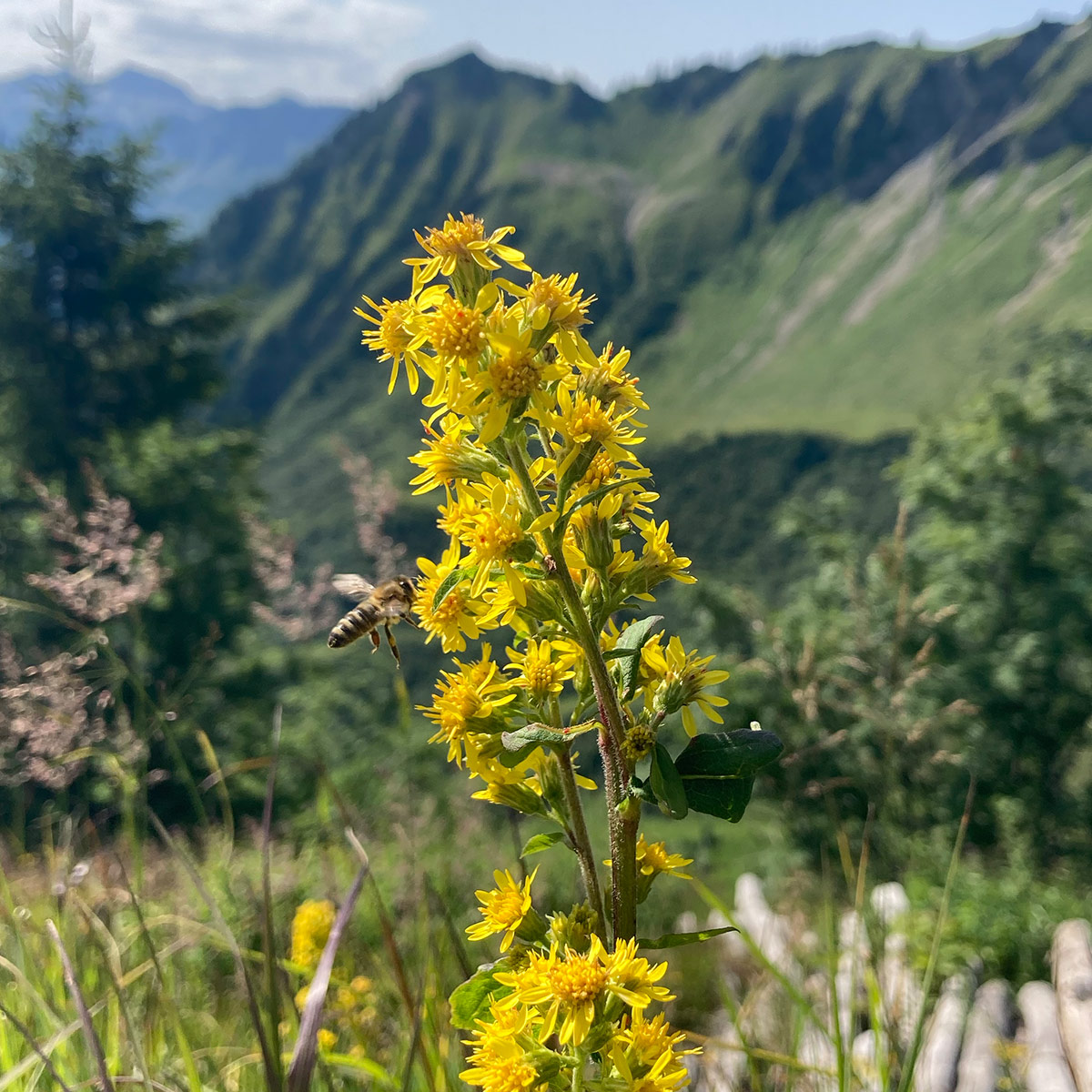Botanical name
Solidago virgaurea L.
Solidago gigantea Aiton
Solidago canadensis L.
Family
Asteraceae
Common name
Goldenrod, European goldenrod (Note: Designation according to HMPC and ESCOP monographs), True goldenrod, Giant goldenrod, Canadian goldenrod
Information about the plant
The polytypic species European goldenrod (Explanation: Toady, in biological systematics, a group of species is better described as a “polytypic species”. This refers to a species that has a relatively wide geographical distribution and occurs in many subspecies) is spread over large parts of Europe, Asia (with the exception of the subtropical part), North Africa, and North America. In Europe, there are two subspecies (ssp.), Solidago virgaurea ssp. virgaurea and ssp. minuta. The latter is common in the heart of Europe's high mountains, not below 1500 m. The ssp. virgaurea is used medically; it grows in light grassland, deciduous and mixed forests, meadows, and rough pastures; it can also reach higher mountain areas. The other two goldenrod species, the Giant goldenrod and Canadian goldenrod, are native to North America and naturalized in Europe, although the Canadian goldenrod is now widespread in central Europe in shoreline thickets, along roadsides and on fallow land.
The genus name Solidago is derived from the Latin "solidus" (= firm, hard) with the common suffix "ago", clearly indicating that the plant is intended to help treat bone fractures. The species epithet virgaurea is made up of the Latin word "virga" (= sprig, rod) along with the Latin word "aurea" (= golden), referring to the bright yellow color of the flowers. This characteristic is also expressed in the English common name "Goldenrod".
The European goldenrod (photo) grows up to 1m high. It is characterized by the bright yellow flower heads, which stand together in simple or compound racemes. The 6-12 ray florets are also loosely arranged around the yellow disc florets. The flowering time is from July to September. The lower leaves are ovate or elliptical, the middle leaves are oblong-elliptical, and the upper leaves are more or less sessile and slightly lanceolate. In terms of the leaf shape, its hairiness and the arrangement of the flowers, it is a very polymorphic type. We have refrained from a subdivision into varieties and forms.
Medicinally used parts of plants (herbal drug)
The dried above-ground flowering parts of the three Solidago species are used, consisting of the stems, leaves, and flowers. The European goldenrod is the source of the European goldenrod herb (Solidaginis virgaureae herba), the giant goldenrod and the Canadian goldenrod are the sources of the "goldenrod herb" (Solidaginis herba).
The commercially available drugs come from cultivations in Germany, Poland, and the Balkan countries.
Constituents of the herbal drug
European goldenrod herb contains flavonoids, triterpene saponins (virgaurea saponins) and phenol glycosides. With its flavonoids and triterpene saponins, goldenrod is chemically very similar to true goldenrod; phenol glycosides are absent.
Quality of the drug
The quality of the following drugs or drug preparations is specified in the European Pharmacopoeia (Ph. Eur.):
- European goldenrod herb (solidaginis virgaureae herba)
- Goldenrod herb (solidaginis herba)
Medical applications
Recognised medical use
The HMPC has classified the European goldenrod herb as a traditional herbal medicinal product (see "Traditional use").
ESCOP: European goldenrod herb: to irrigate the urinary tract, especially in cases of inflammation and kidney stones, and as an adjuvant in the treatment of bacterial infections of the urinary tract.
Traditional use
European goldenrod herb was classified by the HMPC as a traditional herbal medicine (Article 16a of Directive 2001/83/EC). Based on long-standing use the European goldenrod herb may be used for increasing urine volume and thus be an adjuvant in treatment of minor urinary complaints.
Herbal drug preparations in finished dosage forms
- Cut European goldenrod herb as tea
- Dried extracts in tablets, capsules, and instant teas
- Alcoholic extracts in drops and juice
- Fluid extract in drops
- Aqueous extracts in solutions
- Solidago virgaurea homeopathic mother tincture in drops
Dosage
Finished medicinal products: see patient information leaflet.
Tea infusion: drink a cup of European goldenrod tea 2 to 4 times a day between meals; the average daily dose is 10 to 20 g of drug. It is useful to combine it with other drugs like restharrow, orthosiphon leaves, birch leaves or nettle leaves (bladder and kidney tea, urine tea).
Preparation of a tea
Pour approximately 150 ml of boiling water over 3 to 5 g (1 to 2 tsp) of finely chopped European goldenrod herb and strain after 10 to 15 minutes.
Notes
During purging therapy, it is important to drink enough fluids.
Purging therapy with European goldenrod herb cannot be performed if there is edema due to impaired heart and kidney function. A combination with synthetic diuretics is discouraged. There are no safety studies available on the use of (true) goldenrod herb during pregnancy and lactation or in children under 12 years old.
Side effects
Mild stomach discomfort at most.
Interactions
None known.
References
Herbal drug monographs
HMPC (2008, 2021), ESCOP (2018)
Further literature
Commentary on the European Pharmacopoeia (Goldenrod, No. 1893; Goldenrod, No. 1892)


